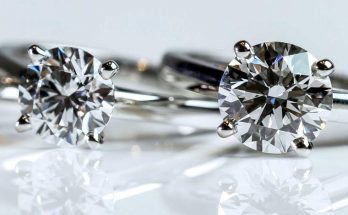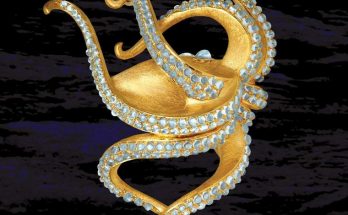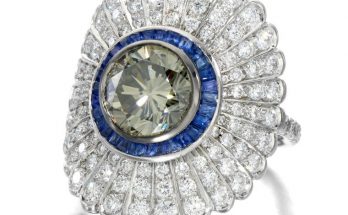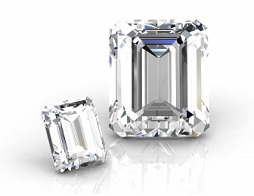
Elegant Classic Elongated Look
Back in the Art Deco period, the emerald cut diamond was an extremely popular choice for engagement rings. The cutting style featuring stacked terraces and large parallel facets was initially developed for emeralds (green colored gemstones) and was later adapted for diamonds due to its popularity.
Emerald cut diamonds usually take on a rectangular outline and have “blocked corners” to give the outline a distinct classic appearance. As a result of its step cut and parallel faceting structure, emerald cuts don’t bend or reflect light as much as the round diamonds.
Consequently, this leads to a loss in brilliance and scintillation properties which makes the emerald cut very poor at hiding material flaws present in the rough stone. Also, having a huge table facet is like having a big open window which enables you to peer deep into the diamond’s body. This means that any inclusions, flaws or color nuances are easier to be picked out compared to the round diamonds.
The Unique Properties of the Emerald Step Cutting Style
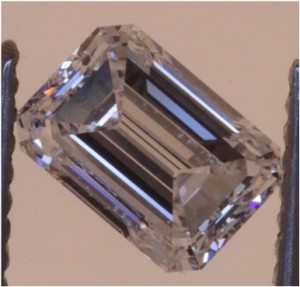
What really makes an emerald cut nice?
The scintillation pattern of an emerald cut diamond differs from those found in brilliant cutting styles like the rounds or ovals. Instead of having tiny sparkles of light emitting from the facets, emerald cuts flash “on” and “off” due to the step faceting structure.
Combined with its classic appearance, this unique optical property is the main reason why women have a soft spot for the emerald shaped diamond. Also, for people who love vintage designs and sophisticated elegance, you’ll find this shape to be a very suitable choice for you.
Ideal Emerald Cut Diamond Proportions Table
| Excellent | Very Good | Good | Fair/Poor | |
|---|---|---|---|---|
| Table % | 61% – 68% | 59% – 70% | 58% – 72% | Outside Ranges |
| Depth % | 60% – 65% | 57% – 68% | 56% – 70% | Outside Ranges |
| Polish/Symmetry | Excellent – Very Good | Good | Outside Ranges | |
| Length to Width | 1.30 – 1.50 | 1.20 – 1.60 | 1.10 – 1.70 | Outside Ranges |
| Girdle Thickness | Thin – Slightly Thick | V. Thin – Very Thick | Outside Ranges | |
| Culet Size | None | Very Small | Small | Outside Ranges |
* Note: The recommended emerald cut diamond proportions should be used as a reference only. A physical examination or a video to show shape appeal will take precedence when you are deciding on its outline. I also strongly encourage you to utilize light performance tools like ASET to assess cut quality.
General Recommendations When Choosing Emerald Shaped Diamonds
In emerald cut diamonds, the body color of the stone can show up very easily. It is even more readily apparent if you intend to buy larger sized diamonds above 1 carat. For this reason, I recommend that you to get a stone within the D – G color grades if you are color adverse.
Due to the lesser brilliance and scintillation of the step cut, inclusions can also show up easily to the naked eye. To maintain eye-cleanliness, a higher clarity grade of VS2 or better is recommended. In my experience, I rarely come across eye clean SI1s or SI2s for emerald cuts and you do have to pay a little more for better quality diamonds.
Now, buying a great looking emerald cut diamond can be a very tricky affair especially for first time shoppers. Beyond the grading report, you need to make use of other available resources to help you make a rational decision. On the next page, I’m going to show you the crucial things you need to take note of when shopping for a diamond…
>>

